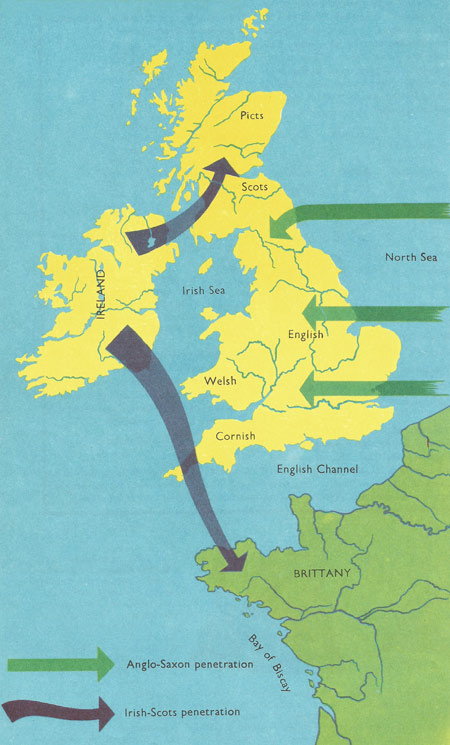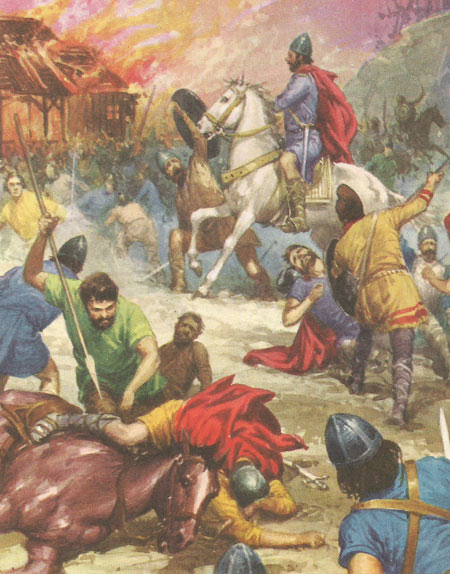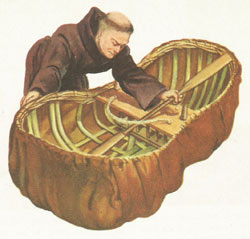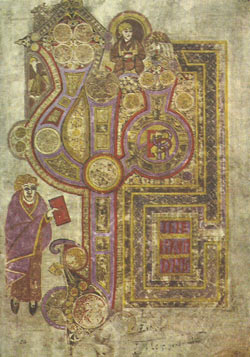Celtic lands

Celtic lands.

Very little is known for certain about King Arthur, but there are many legends about a great Celtic hero who fiercely resisted the Anglo-Saxon invaders. He is believed to have won many victories, the most famous of which is Mons Badonicus. The site of this battle maybe near Swindon..
The Celtic lands are on the Western edges of the European land mass; they are Scotland, Ireland, the Isle of Man, Wales, Cornwall and the Western part of France called Brittany.
A long time ago the Celts are believed to come from Asia and to have drifted westward until they settled on the edge of the then known world. At one time the Celts occupied the Whole of Scotland, England, and France, but they were pressed on to the edges of these lands by wild marauders from Northern Europe. Archaeologists digging in Europe and Asia still come across remains of early Celtic settlements left there during the trek westward, and as proof of the Celtic occupation of Britain there is the fact that shepherds on the Cumberland hills today still count their sheep in Celtic numerals instead of in English. Centuries ago, before the Roman conquest, Celtic languages were spoken all over the west of Europe but they were swamped by Latin, the language of the powerful Roman conquerors and were further diluted after the Romans left by the languages of successive waves of conquerors, such as the Danes and the Anglo-Saxons, so that modern English shows traces of many other languages and Modern Englishmen are descended from many races. The Celts nevertheless, with varying success, have maintained their languages. Welsh is still a living language in everyday use, with a great store of literature which is being continually increased. Breton is also a living tongue, while the Gaelic is still spoken in parts of Ireland and Scotland and modern educationists encourage its use. The Celtic people have a great affinity for each other, though they do not always understand each other's language. A Gaelic-speaking Highlander from Scotland, for instance, would find it difficult to understand a Breton fisherman from Finisterre. Nevertheless, there is a great feeling of kinship, particularly in literature, and every year poets and writers from Wales, Scotland, Ireland and Brittany meet together to express their brotherhood, and every three years representatives of all the Celtic countries meet together in a Celtic Congress which lasts for several days.
One of the great unifying forces of the Celtic nations is their common claim to the mystical King Arthur who flourished about the year 500. Stories about Arthur are found in the folklore and legends of all the Celtic lands and though nobody knows the source of the legends it is obvious that Arthur was a great leader and a dominant personality and that with his Celtic mysticism he managed to combine a regard for justice and the rights of man which the Romans had brought with them when they came to the Western lands. Arthur was brave and chivalrous and the ideals which he and his Knights of the Round Table managed to instil into people have echoed down the centuries in the literature and music of many lands. You will find the Arthurian stories in the chronicles of Geoffrey on Monmouth, in Mallory's Morte d'Arthur and in Tennyson's poems, as well as in the music of Parsifal and other operas by Wagner.
 |
| Celtic missionary and his coracle
|
The Celts are mystics and are credited with a special gift of being in tune with the mysterious. They were among the earliest Christians and had established Christian cells in remote corners of the Celtic lands even before St. Augustine came to England. Islands had a fascination for them and colonies of holy-men gathered on islands like Iona off Scotland and Bardsey off Wales, and they would visit each other in frail little boats even crossing the rough water between Scotland and Ireland and Wales and Brittany. The Celtic church produced many saints and scholars in those early centuries. In the small village of Llantwit Major on the edge of the sea in South Wales there was in the fourth century a famous colony of holy men and teachers which acquired continental fame and at one time seven sons of kings were being educated there in the care of St. Illtyd. It is one of the very earliest universities known to history. St. Patric of Ireland was one of the holy men of the early Celtic church, and in Wales there was St. David, St. Illtyd, and St. Padarn.
 |
| The Book of Kells: one of the beautiful illuminated manuscripts of the Celts.
|
Three of the most ancient books in the British Isles have come from Celtic lands. They are extremely precious but they may still be seen. They are the gospel of Lindisfarne which originally came from a religious foundation on Strathclyde and is now to be seen in the British Museum; the Book of Kells, a beautifully ornamented book from an Irish religious foundation now to be seen in Dublin, and the Black Book of St. David's a collection of writings of religious men in Wales which is now in the National Library of Wales in Aberystwyth.
